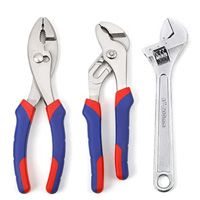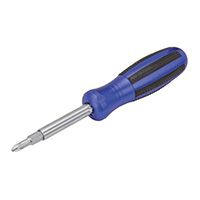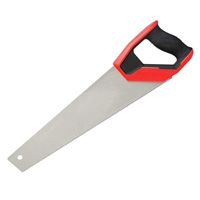Project details
Skill
Cost
Estimated Time
Garbage disposals reduce kitchen waste and can prevent plumbing issues caused by food debris. With the right tools and knowledge, you can tackle installing one yourself. In the video above, Ask This Old House plumbing and heating expert Richard Trethewey demonstrates the step-by-step process of installing a garbage disposal in a kitchen sink.
Understanding Garbage Disposals
Garbage disposals grind food waste into small particles that can easily flow through your plumbing system. They offer several benefits to homeowners, including:
- Reduced risk of plumbing drain damage from food debris
- Less trash generated from food waste
- Decreased kitchen odors from rotting food
Key Components
A typical garbage disposal has these components:
- The disposal unit
- Sink flange
- Mounting assembly
- Dishwasher connection (if applicable)
- Drain pipes and fittings (Schedule 40 PVC should work for most of this project)
Materials
To install a garbage disposal, you’ll need the following tools and materials:
Tools
Preparing to Install Your Garbage Disposal
Take these steps before beginning the installation:
- Turn off the power to the disposal circuit at your home’s electrical panel.
- Disconnect the P-trap from the drain tailpiece with a wrench.
- Cut the P-trap near where it exits the cabinet, likely the side or back, with a mini hacksaw. Keep a bucket underneath the P-trap for any waste or sludge buildup. A P-trap will always retain a bit of water—this prevents sewer gasses from rising up through the drain.
- Disconnect the sink stopper and the tailpiece from the sink, which can be done from underneath with a wrench.
- Clean the old putty on the top of the sink.
Step-by-Step Garbage Disposal Installation Process
Follow these steps to install your new garbage disposal:
- Apply plumber’s putty to the bottom of the new sink flange and place it in the drain hole.
- Secure the sink flange to the counter from underneath. Older models will use three screws, while many current models use a plastic, hand-tightened ring.
- Most models have a knockout hole that you can punch through to run the dishwasher hose, if necessary.
- Attach the disposal to the mounting ring on the sink flange. It usually twists right on and can be hand-tightened.
- Next, connect the P-trap. The hole for the drain line is usually on the side of the disposal, so you’ll need to run and connect new drain pipes.
- Seal all the new P-trap connections.
- Open the faucet and check for any leaks.
- Plug the disposer into the outlet or call an electrician to wire the disposal to power.
Plumbing Connections for Garbage Disposals
One of the trickier aspects of installing a garbage disposal is connecting it to your existing plumbing. Trethewey recommends using repair couplings to help navigate small, tight spaces. When sizing plumbing, he advises checking whether your pipes are measured by their inside diameter (ID) or outside diameter (OD).
Electrical Considerations For Garbage Disposals
Most garbage disposals require a dedicated electrical circuit. If you don’t have an existing outlet under your sink, we recommend hiring a licensed electrician to install one. Some key points to remember:
- Use a ground fault circuit interrupter (GFCI) outlet for added safety.
- Ensure the circuit can handle the amperage of your disposal unit.
- Follow local electrical codes and regulations.
Testing Your Garbage Disposal and Troubleshooting
Now it’s time to test your new garbage disposal:
- Turn on the water and run it into the sink.
- Plug in the disposal or turn on the power at the circuit breaker.
- Flip the switch to activate the disposal.
- Listen for any unusual noises and check for leaks under the sink.
If you encounter any issues, such as leaks or strange sounds, double-check all your connections and make sure everything’s tightened properly.
Garbage Disposal Maintenance Tips
To keep your new garbage disposal running smoothly and avoid disposal repairs, follow these best practices:
- Always run cold water when using the disposal.
- Avoid putting fibrous or starchy foods down the disposal.
- Clean the disposal regularly with ice cubes and citrus peels.
- Never put your hand inside the disposal—use tongs or pliers to remove objects.
Trethewey suggests installing a clean-out plug if possible. You can remove this plug when needed to make cleaning and maintenance easier. Make sure you buy one that can withstand the water pressure in the system.
Types of Garbage Disposals
Understanding the different types of garbage disposals can help you choose the right one for your home. The two main types of garbage disposals are continuous feed and batch feed. Here’s how they stack up:
| Type | Description | Pros | Cons |
|---|---|---|---|
| Continuous Feed | The most common types found in homes are continuous feed systems. They run with a wall switch and can handle a continuous stream of food waste. To use it, turn on the cold water, flip the switch, and feed food waste into the disposal. | • Easy to use with a wall switch • Can handle large amounts of food waste • Generally more affordable | • Requires attention to avoid overloading • Slightly higher risk of objects falling in • Needs a power switch, which some find less user-friendly |
| Batch Feed | Batch feed disposals require a stopper or cover to activate the unit. You load the chamber with food waste, insert the stopper, and then the disposal grinds up the waste. These units are generally safer because they only run when the stopper is in place. | • Safer operation with stopper-activated mechanism • Less risk of objects falling in • Generally quieter | • Batch operation process can be slower • Typically more expensive • May require more space under the sink |
Resources
Richard installed a Badger 100 1/3 HP Continuous Feed Garbage Disposal manufactured by InSinkErator.
You can find the other tools and materials he used to install the disposa at home centers and plumbing supply houses.



